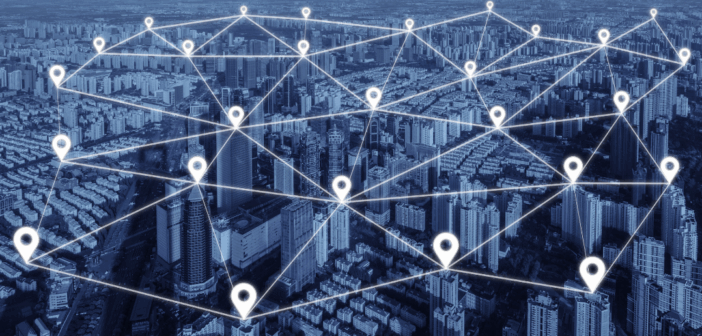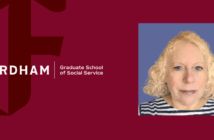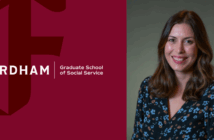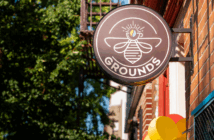What should communities prioritize in their digital infrastructure as the world continues to rapidly innovate, particularly with advancements in artificial intelligence (AI)? Should it be governance and policy-making, which guide us toward frameworks and responsible AI use? Or should we focus on the trust, relationships, and collaboration that make innovation meaningful?
The Bronx AI Access Initiative (BAi2) has set out to provide an answer. Spearheaded by Fordham GSS Professor Lauri Goldkind, Ph.D., and Fordham School of Law Associate Professor Aniket Kesari, Ph.D., BAi2 was launched through a collaboration between Fordham University and WHEDco. The project seeks to build more digital capabilities for community-based organizations (CBOs) in the Bronx, helping the community keep pace with digital advancements.
Funding for this initiative is provided by the Bronx Research Institute for Community Solutions (BRICS), a program of Fordham University’s Center for Community Engaged Learning (CCEL).
BAi2 members met virtually on Monday, June 30, for a “Community Shareout” event, discussing their work and findings since beginning the project in January of this year.
Listening for Opportunities and Challenges in Digital Tech
As with most successful initiatives, the BAi2 team began its journey by listening to the community. The group met with over 100 leaders and staff of Bronx-based nonprofit organizations through a series of virtual workshops in January and February of this year to discuss experiences and perspectives on AI in their communities and work.
“We heard a broad range of understanding about what these tools are and how they can support workers,” Goldkind said, “as well as concerns about the ethical challenges inherent in implementing [them].”
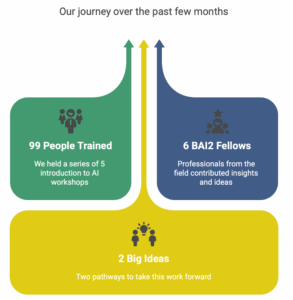 The workshops revealed a major challenge to digital implementation: despite the borough’s commitment to digital fluency, many decision-makers in these CBOs are not what Goldkind called “tech champions.” In fact, often they are “tech skeptics,” with good reason!
The workshops revealed a major challenge to digital implementation: despite the borough’s commitment to digital fluency, many decision-makers in these CBOs are not what Goldkind called “tech champions.” In fact, often they are “tech skeptics,” with good reason!
Workshop participants mirrored the range of responses that are happening nationally.
“We heard everything from enthusiasm and interest in using large language models for content generation, to deep concerns about AI bias and extractive environmental justice practices,” Goldkind said. “[The question for BAi2 was] How do we use these tools to do real-time assessment and make them work for us in the most useful and responsible way? Where can we accelerate the good work people are doing, without creating barriers and being sensitive to possible harms?”
Those initial workshops also informed how BAi2 built out its fellowship program. The group invited community members to apply for a six-week fellowship. A total of fourteen individuals applied, and ultimately six fellows were selected to work with Goldkind and Kesari for the second phase of the project.
Scanning the Landscape
BAi2 and the Fellows engaged in a range of foresight-focused exercises to gain a greater understanding of the digital capabilities landscape in the Bronx. First, they completed a stakeholder analysis focused on an assessment of the existing digital infrastructure within Bronx CBOs and finding the key decision-makers who can help execute a plan to further adopt digital technology in the workplace.
Next, they did a signal scan, a classic foresight strategy where the group explored the latest trends in their professional fields and personal newsfeeds concerning relevant socio-technical breakthroughs. BAi2 members used the “STEEP” (social, technical, economic, environmental, political) framework to guide their thinking and help organize their signals.
The results of the signal scan highlighted how the rapidly shifting political climate and societal norms are reflected in the country’s changing laws and language, making it difficult to establish frameworks for new digital engagements. These have combined with the “always on” pressure that increased digitization, access to devices, and work-from-home policies brought during the COVID-19 pandemic. This resulted in many ethical quandaries with no easy solutions.
“We recognize that these digital tools are important, but they’re creating new ethical, legal, and policy dilemmas,” Goldkind said.
Searching for Solutions: Two Paths Forward
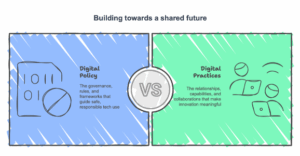
The possibilities of the future are limitless with these new technologies, said Tameka Vasquez, a futurist and strategist at The Future Quo who is supporting BAi2 with its work. And since many of these potentials come with ethical uncertainty, it’s even more important that we familiarize ourselves by critically evaluating new tools as they enter the marketplace.
Vasquez described educational opportunities as on a continuum, from individualized study to collective learning. The latter, she explained, is crucial to community advancement. Organizations and societies must ask themselves: How can we shift away from isolated problem-solving and toward collective action? The solution, she said, comes from sharing sugar.
“Sharing sugar” is a metaphorical collective process where communities share resources to foster true collaboration. The idea is paramount to the social sector as it adopts new technologies, Vasquez said, but it isn’t a new one; public libraries and food co-ops are two examples of sharing sugar done tremendously right.
“Public libraries were an idea of having access to a wide range of things without having to own them ourselves,” she said. “We can pool our resources and offer that to more people.”
BAi2 and its fellows identified two pathways that can help guide this communal effort of shared resources: Digital Policy and Digital Practice.
A digital policy hub could bring rules, frameworks, and governance to Bronx-based nonprofits to guide responsible tech use. It would provide clarity and set a standard for ethical and beneficial tech use cases. When you have unlimited potential, controlling that power is the only way to ensure it gets used for good.
“As long as we harness this power, the conversation shifts from, How do I keep up? to, What can we do collectively more impactfully, supercharged by these capabilities?” Vasquez said.
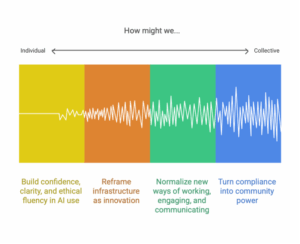
A digital practice hub, on the other hand, comprises the relationships, capabilities, and collaborations that make innovation meaningful. This option offers more concrete shared resources, exemplified by the possibility, for example, of a hub-sponsored data analyst who could assist all hub members with skills like data storytelling, data visualization, and new algorithmic implementations.
The digital practice hub asks, “How can we enhance capacity and coordination, and how do we define success in a future that is collective, not individual?”
Both pathways have their place in the discussion, but which is the priority? Answering this will be BAi2’s guiding question moving forward as the group and its fellows work toward a collective-centered digital future in the Bronx. They hope to continue their momentum with partner WHEDco in the fall.
